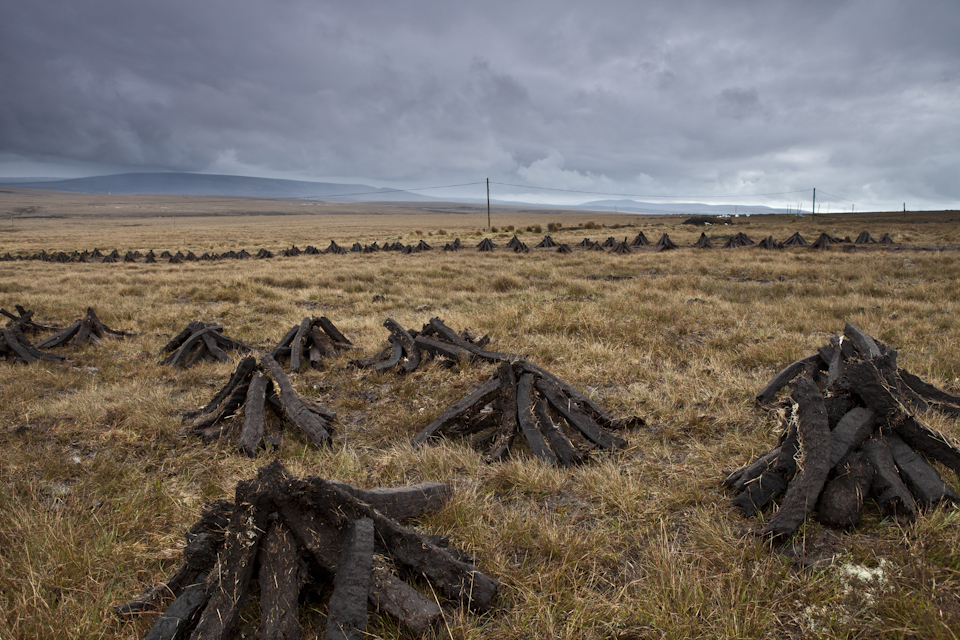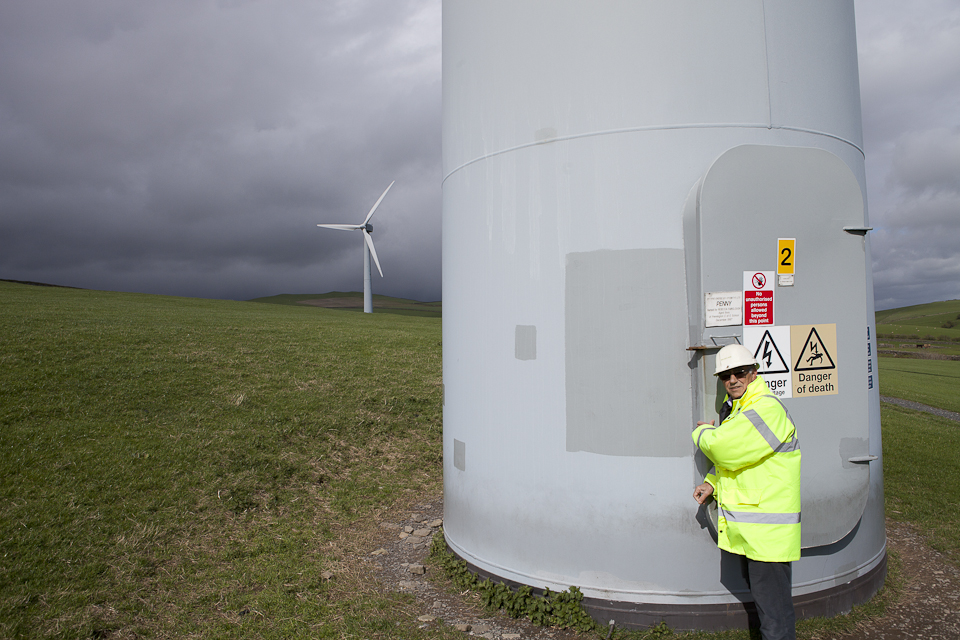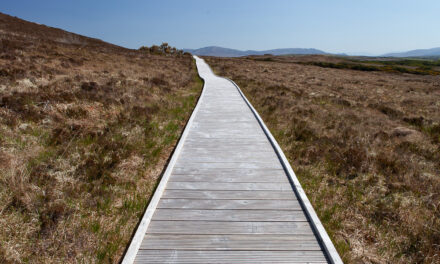East Anglia lies at the heart of a heated debate on the expansion of onshore wind farms across England. The battle to secure or defeat planning applications for new wind turbines is in the balance, as the following two stories illustrate. In May 2012, a High Court judge ruled that it is “not correct to assert that the UK national policy promoting the use of renewable resources negates the local landscape policies or must be given ‘primacy’ over them”. The small community of Hemsby, Norfolk had defended the countryside against the unwelcome “invasion” of four 105-metre high turbines. This judgment provided the inspiration for my decision to choose Norfolk and East Anglia as the starting point for a photography project that explores the visual impact of wind power on the landscape. Fast-forward to January 2013 and take a short drive through the pleasant Norfolk countryside to the communities of Bagthorpe and Stanhoe. An application to erect 11 turbines on two wind farms reached the High Court again. But this time the same judge, Mrs. Justice Lang, rejected claims that the turbines would spoil views from nearby Bloodgate Hill Fort (it should be mentioned that no structure or ruins actually exist here).
A multitude of reasons are put forth for opposing wind farms but the truth behind many claims is simply that some people don’t like the look of them (Why there’s only one honest objection to wind farms). Ill-informed or misleading attempts to discredit technology, cost, subsidies and efficiency are often used to disguise the true reason for opposition. Having said that, visual impacts of wind farms on landscape are certainly a legitimate concern and deserve to be debated in an open and transparent way. After all, does landscape not inspire us, inform our sense of identity, nurture our soul, and underpin our quality of life?
Now time for some number crunching to dispel myths and inaccuracies on the size of the wind industry. The UK Wind Energy Database (UKWED) is the most comprehensive source of data on wind power in the country. It currently lists 370 wind farms containing more than 4,300 wind turbines across the whole of the UK (both onshore and offshore). These generate around seven gigawatts of power and save almost seven million tonnes of CO2 that would otherwise be generated by fossil fuels. The East of England, which includes East Anglia, has 24 operational wind farms with 253 turbines, 87 of which are onshore (an average onshore wind farm contains just four turbines). A further 110 turbines (77 onshore) are currently under construction and another 84 turbines (83 onshore) already have planning consent. In all, we are looking at a potential 247 wind turbines onshore spread across the second largest region of England. Too many for some people, but to put this in perspective, the single largest onshore wind farm in Scotland (Whitelee) has 140 turbines with construction of a further 75 turbines due to be completed next month. That said, visual impact on landscape is not a simple numbers game.
So where do the leading organizations that champion the English landscape stand on the visual impact of wind farms? Before we go any further, it should be noted that all the organizations mentioned in this article have taken an official position that recognizes the need for positive action on climate change. Leading the charge is the environmental charity, Campaign to Protect Rural England (CPRE), which claims to be “standing up for the countryside for over 80 years”. The acclaimed author Bill Bryson, is currently President of the CPRE and happens to live in Wramplingham in rural Norfolk. A recent newspaper article in the Telegraph quotes him as saying that, “the wave of planning applications for wind turbines across the country risks unacceptable damage to the landscape; to localism and people’s confidence in the planning system; and, ultimately, to the battle against climate change”. Ironically, the English countryside is already losing the war against climate change due to extreme weather events, such as flooding, with 2012 officially classed as the wettest year in England on record. More on localism and confidence in the planning system later.
Scottish Natural Heritage (SNH) leads the UK as a whole in terms of publically available guidance with a well-written and comprehensive document, “Siting and Designing wind-farms in the landscape”. Their process of assessing landscape and visual impacts is rigorous and easy to follow. English Heritage appears to play a much more limited role than it’s Scottish counterpart with respect to landscape, focusing solely on the historic environment and cultural heritage. The last report available on their website to address the issue is dated from 2005 (Wind Energy and the Historic Environment). Similarly, the Landscape Institute (LI) has not updated its guidance since the publication of “Guidelines for Landscape and Visual Impact Assessment” in 2002, although it has posted a number of responses to reports from other organizations such as the Department of Energy and Climate Change (DECC). Incidentally, the LI is an educational charity and chartered body for landscape architects that champions the protection, conservation and enhancement of the natural and built environment.
Stepping into the void is Natural England, the public body with statutory responsibility for protecting and improving England’s natural environment. Their 2010 report “Making space for renewable energy: assessing onshore wind energy development” calls on the Government to allow local planning authorities and the Planning Inspectorate to put greater emphasis on local plans when making decisions. In theory, a county council should have a deeper understanding of local landscape and the residents that are part of it but local politics is far more complex than that. Just how can the UK meet its own carbon reduction targets under the Climate Change Act unless it adopts a strategic approach at national level that recognizes wind farms have to be built somewhere? I recognise that some people firmly believe onshore wind farms should not be built at all but offshore is still too expensive, and no other renewable energy source currently exists that is scalable and relatively affordable today. Unfortunately, local communities are largely not the beneficiaries of wind power (apart from landowners) and until public policy is changed, local communities and councils will continue to be naturally predisposed to oppose wind farm development.
Let’s take a look at the process behind making a decision on the landscape impacts of wind farms. A Landscape and Visual Impact Assessment (LVIA) is a standard process of examining the landscape and visual effects of a development. This is most often performed by a Chartered Landscape Architect in a structured and consistent way using professional judgment. An LVIA is usually required for every wind farm proposal regardless of whether a larger Environmental Impact Assessment is carried out. Visual tools such as photographs, photomontages and Zone of Theoretical Visibility (ZTV) maps are used to present the information clearly and concisely for all to understand. The local planning authority then makes a decision to reject or approve planning consent based on all of the evidence gathered (economic, technical, environmental). A disappointed applicant has the right to appeal to the Secretary of State, where a Planning Inspector is normally appointed to review the application. A further level of appeal is possible in the High Court.
Natural England assesses landscape and visual impact by taking statutory protected sites, landscape character and historic and culture heritage into account. Landscape character is the result of the unique combination of elements that makes one place different from another including geology and ecology, culture and history, aesthetics and perception. A Landscape Character Assessment (LCA) tries to objectify judgments but there will always be subjectivity when dealing with aesthetics and perception. The sense of relative remoteness, tranquility, artistic, literary and historic associations are difficult, if not impossible, to quantify as they vary from person to person. Nevertheless, the CPRE has attempted to quantify “tranquility” by producing a colour-coded map largely according to the urban/rural divide and plotting wind farms alongside.
CPRE published a dedicated report with recommendations in April 2012, “Generating light on landscape impacts: How to accommodate onshore wind while protecting the countryside”. Their website expresses a vision where green energy is in harmony with the landscape; increasingly in small-scale networks which benefit local communities and minimize damage to the environment. However, small-scale networks are potentially more damaging to the landscape and make less efficient use of infrastructure, as more grid connections, access roads, substations and pylons need to be constructed. Additionally, extra caution is needed due to the greater cumulative effect on the landscape. SNH offers useful guidance on this topic suggesting that new wind farms should take into account existing ones, avoid dominating existing focal points or distinctive skylines and complement the landscape character in terms of positioning, extent and density. This ties in closely with the capacity of the landscape to absorb man-made structures such as wind turbines. Perhaps fewer and larger wind farms located in the most appropriate landscapes could be a better solution overall, especially in parts of the country such as East Anglia?
CPRE has expressed its concern that wind farms “are increasingly being directed towards more remote, tranquil areas”. The Lake District in Cumbria stands out as one protected region that has a cluster of wind farms lying close to the northwest edge of the Park. One reason for this is public opposition by local residents to proposals for wind turbines near inhabited areas. The UK has precious few wilderness areas confined largely to remote parts of Scotland and a handful of large National Parks. Such landscapes are most sensitive to any human footprint no matter whether a whitewashed bungalow, an electricity pylon or even a wind turbine. England currently has no legal separation distance between housing and wind turbines, although an independent study on noise limits suggest a minimum distance of 350 metres. In Scotland, which is much less densely populated than England, the recommended distance is 2km and this figure drops to 500m in Wales. If England were to follow Scotland’s lead (some councils such as Lincolnshire are already pushing for this), then it would force wind farms into ever more rural and remote landscapes thus destroying the unique visual amenity that these few remaining landscapes provide. A concerted campaign of NIMBYism (Not In My Back Yard) means that onshore wind turbines are either pushed into (or close to) uninhabited and protected landscapes, or they not built at all.
We need to recognize that since the UK has the highest population density of any large country in Europe, rural communities and wind farm developers have a greater likelihood of coming into conflict as they compete for access to limited land resource. This article does not intend to debate the potential solutions to this conflict although it would appear that there is a need to increase community engagement in renewable energy. Two-thirds of turbines are owned by individuals and local communities in Germany where acceptance of wind farms is unsurprisingly far greater than in the UK (only 10% of wind farms are community owned here). A change in government policy to incentivize community ownership could be one way of encouraging people to view wind farms differently. Nevertheless concerns about the visual impact of wind farms in the landscape are real and should be respected. The current process for assessing such impacts may not be perfect but at least it has been formalized and is open to influence by the main stakeholders already mentioned. Sensitive landscapes such as National Parks, Areas of Outstanding Natural Beauty and Sites of Special Scientific Interest should continue to be rigorously protected when reviewing wind farm applications. But it is in the bordering areas and in the open countryside where the greatest risk of conflict lies. One thing is for sure; the debate is far from over.
Originally published in 2013






Recent Comments